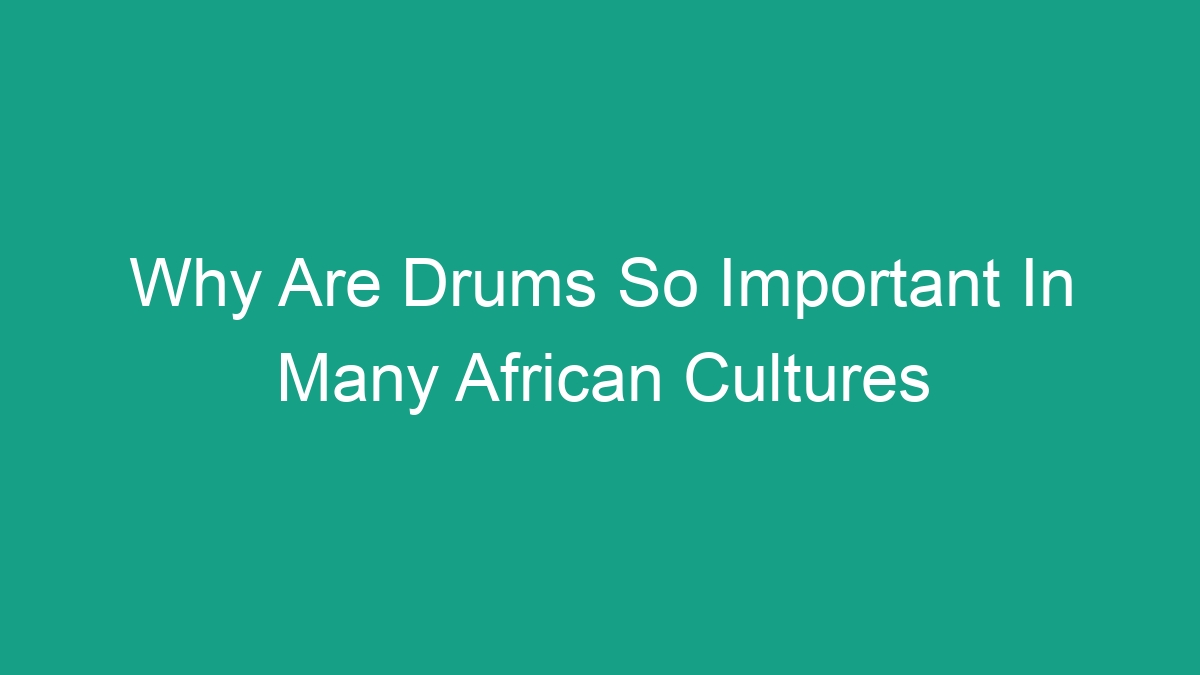
Africa is a continent rich in culture and tradition, and one of the most prominent features of many African cultures is the use of drums. Drums have played a significant role in African societies for countless generations, and their importance extends beyond just music and dance. In this article, we will explore why drums are so important in many African cultures and how they have shaped the cultural identity of the continent.
The Role of Drums in African Culture
1. Communication
Drums have been used as a means of communication in African societies for centuries. Different rhythms and beats can convey specific messages and information, allowing people to communicate across long distances. In some cultures, specific drum patterns are used to announce important events, declare emergencies, or even communicate with neighboring communities.
2. Ceremonies and Rituals
Drums are an integral part of traditional African ceremonies and rituals. Whether it’s a birth, a coming-of-age ceremony, a wedding, or a funeral, drums are used to set the tone and create the mood for these important events. They are believed to connect the physical and spiritual worlds and are often used to invoke ancestors or spirits during religious or ceremonial activities.
3. Music and Dance
Music and dance are essential components of African culture, and drums are at the heart of these art forms. Drums provide the rhythmic foundation for traditional African music and dance, and they are used to accompany storytelling, celebrations, and social gatherings. Different types of drums are used for various musical styles and dance traditions, each with its own unique sound and purpose.
The Significance of Different Types of Drums
1. Talking Drums
Talking drums, also known as “dunduns” or “talking drum,” are a type of drum found in West Africa. These drums are designed to mimic the tonal inflections of human speech, allowing skilled drummers to communicate complex messages over long distances. Talking drums are used in various cultural contexts, from storytelling and traditional ceremonies to contemporary music.
2. Djembe
The djembe is a type of drum that originated in West Africa and is widely used in traditional African music. It has a deep, resonant sound and is played with the hands, producing a wide range of tones and dynamics. The djembe is often used in cultural celebrations, dance performances, and communal gatherings, and it holds spiritual and cultural significance in many West African societies.
3. Sabar
The sabar is a type of drum commonly found in Senegal and the Gambia. It is known for its distinct, high-pitched sound and is typically played with a stick and a hand. The sabar is an essential component of Senegalese and Gambian music and dance traditions, and it is often used in traditional wrestling events, religious ceremonies, and social gatherings.
The Cultural and Spiritual Significance of Drums in Africa
1. Ancestral Connection
Drums are believed to have the power to connect the living with the spirits of their ancestors. In many African cultures, drumming is used to honor and invoke the presence of ancestors, seeking their guidance and blessings. The rhythms and melodies produced by drums are thought to transcend the physical realm and bridge the gap between the living and the spiritual world.
2. Community Cohesion
Drumming and communal music-making have the power to bring people together and create a sense of unity and belonging within a community. In many African societies, drum circles and music gatherings are not only a form of entertainment but also a way to foster social cohesion, strengthen interpersonal relationships, and reinforce cultural identity.
The Impact of Drums on Global Music and Culture
1. Influence on Music Styles
The rhythms and patterns of African drums have had a profound influence on various music styles around the world. From jazz and blues to rock and electronic music, the rhythmic elements derived from African drumming have significantly shaped the global music landscape. African drumming techniques have been incorporated into countless music genres, contributing to the diversity and creativity of contemporary music.
2. Cultural Exchange
As African music and culture continue to gain global recognition, the significance of drums in African societies has transcended geographical boundaries. African drumming traditions are now celebrated and embraced by people of diverse cultural backgrounds, leading to cross-cultural exchanges and artistic collaborations that enrich the global cultural tapestry.
FAQs
Q: What are some of the most famous African drumming traditions?
A: Some of the most famous African drumming traditions include the West African djembe drumming, the East African ngoma drumming, and the Central African talking drum traditions.
Q: Are drums used in African religious practices?
A: Yes, drums are often used in African religious practices to facilitate communication with spirits, ancestors, and deities. They are an integral part of rituals, ceremonies, and worship in many African indigenous religions and belief systems.
Q: How have African drums influenced modern music?
A: African drumming traditions have had a significant impact on various music styles, including jazz, blues, reggae, and hip-hop. The rhythmic patterns and techniques derived from African drums have been incorporated into contemporary music, shaping the sound and feel of diverse music genres.
Q: What are some modern adaptations of African drumming traditions?
A: In addition to traditional African drumming, modern adaptations and fusions of African drumming traditions can be found in world music, contemporary dance music, and experimental music genres. Artists and musicians around the world continue to draw inspiration from African drumming, creating new and exciting forms of musical expression.
As we can see, drums play a crucial role in the cultural, spiritual, and musical traditions of many African societies. Their enduring significance and influence have not only shaped the identity of African cultures but also contributed to the global cultural landscape, leaving an indelible mark on music, art, and human connection.



